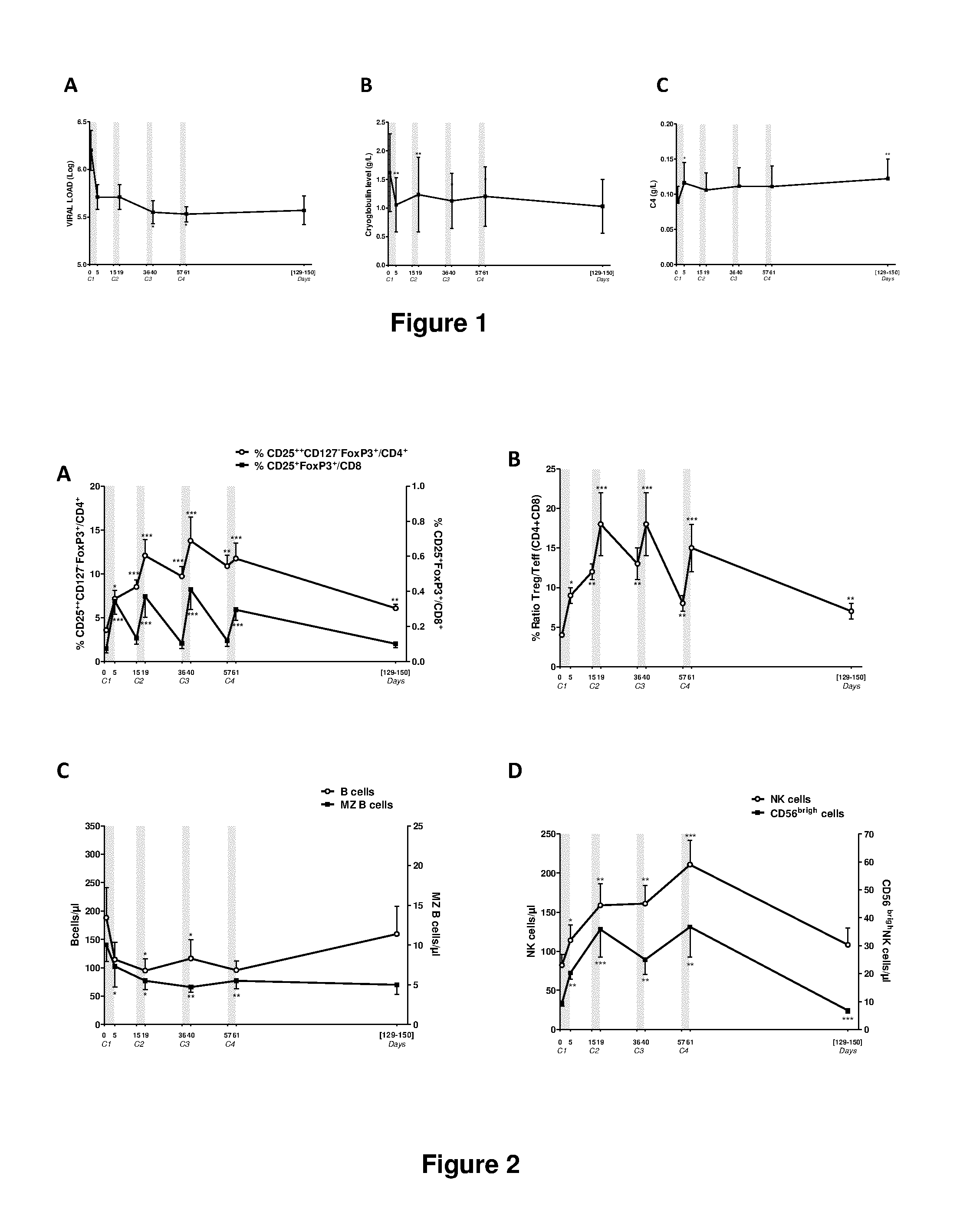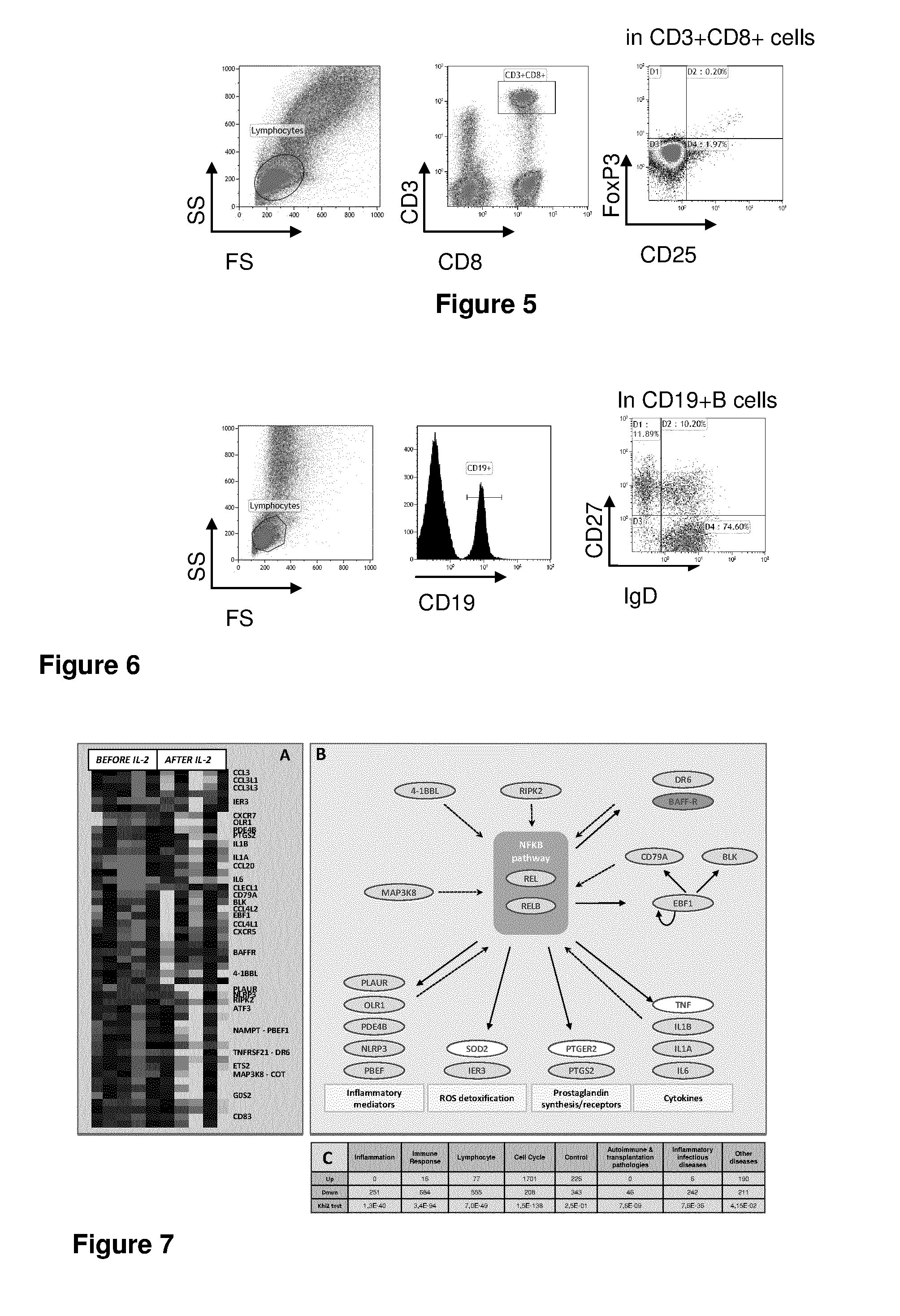Use of low dose il-2 for treating autoimmune - related or inflammatory disorders
a technology of autoimmune or inflammatory disorders and low doses, applied in the field of il2-based therapies of human diseases, can solve the problems of 2 to stimulate teffs and carry risks, and achieve the effect of increasing the treg/teff ratio and shifting the balance of treg/
- Summary
- Abstract
- Description
- Claims
- Application Information
AI Technical Summary
Benefits of technology
Problems solved by technology
Method used
Image
Examples
example 1
Low-dose IL-2 in HCV-related Vasculitis
[0202]Here, we provide the first biological evidence in human subjects that IL-2 can be used under conditions that induce Tregs without inducing Teffs in patients with auto-immunity. We report here the first demonstration of in vivo expansion of very potent supressive Treg through IL-2 immunotherapy in a human autoimmune disease, leading to clinical improvement. The primary end point of our study, increased Treg at the end of IL-2 therapy, and all secondary end points, including the clinical response were all met. We show that low-dose IL-2 is well tolerated, induces a dramatic and selective increase in Treg cells, and leads to clinical improvement in 80% of the patients. This is the first demonstration of in vivo Tregs induction and recovery after IL-2 immunotherapy in a human autoimmune disease. Furthermore, we show for the first time a marked anti-inflamatory effect of low-dose IL-2 in humans.
METHODS
Patients
[0203]Inclusion criteria for the s...
example 2
Low-dose IL-2 in Type 1 Diabetes
[0233]The inventors initiated an IL-2 dose-finding clinical trial in T1D, which aimed to define the lowest active dose that could safely induce Tregs in adult T1D patients.
[0234]The DF-IL2 trial is double blinded, comparing placebo, 0.3, 1 and 3 mIU / day Proleukin® doses (cumulative dose of 1.5, 5 and 15 mIU, respectively).
[0235]The objective of the trial will be to preserve remaining endogenous insulin secretion in patients with recently diagnosed T1D.
[0236]Main patient characteristics: adults, both sexes, T1D diagnosis as WHO-ADA, disease duration since diagnosis of less than 12 weeks at first IL-2 dosing and detectable C-peptide at entry.
[0237]The current recommendation for a clinically meaningful effect is to target with the active treatment at least a preservation of pancreatic β-cell mass, i.e. the maintenance of C-peptide AUCO-120 compared to baseline.
[0238]All 24 patients have been included. Although the investigators are still blind to the IL-...
PUM
| Property | Measurement | Unit |
|---|---|---|
| molecular weight | aaaaa | aaaaa |
| isoelectric point | aaaaa | aaaaa |
| threshold | aaaaa | aaaaa |
Abstract
Description
Claims
Application Information
 Login to View More
Login to View More - R&D
- Intellectual Property
- Life Sciences
- Materials
- Tech Scout
- Unparalleled Data Quality
- Higher Quality Content
- 60% Fewer Hallucinations
Browse by: Latest US Patents, China's latest patents, Technical Efficacy Thesaurus, Application Domain, Technology Topic, Popular Technical Reports.
© 2025 PatSnap. All rights reserved.Legal|Privacy policy|Modern Slavery Act Transparency Statement|Sitemap|About US| Contact US: help@patsnap.com



